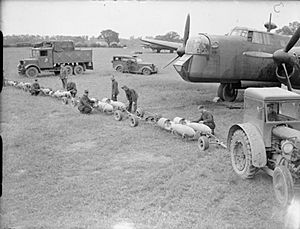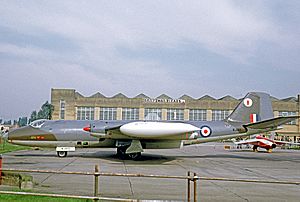No. 58 Squadron RAF facts for kids
Quick facts for kids No. 58 Squadron |
|
|---|---|
| Active | 8 June 1916 – 1 April 1918 (RFC) 1 April 1918 – 1 February 1920 (RAF) 1 April 1924 – 25 May 1945 1 October 1946 – 1 September 1970 1 August 1973 – 4 June 1976 |
| Country | |
| Branch | |
| Motto(s) | Latin: Alis nocturnis ("On the wings of the night") |
| Battle honours | Western Front, 1918: Somme, 1918: Hindenburg Line: France & Low Countries, 1940: Atlantic, 1939–45: Norway 1940: Fortress Europe, 1940–41: Ruhr, 1940–41: Berlin, 1940–41: German Ports, 1940–41: Biscay Ports, 1941–42: Biscay 1942–44: Arctic, 1942–43: Normandy, 1944: Baltic 1944–45: |
| Commanders | |
| Notable commanders |
"Bomber" Harris |
| Insignia | |
| Squadron badge heraldry | On a branch an owl. |
| Squadron codes | BW (Nov 1938 – Sep 1939) GE (Sep 1939 – Apr 1943) BY (Apr 1943 – May 1945) OT (Oct 1946 – Oct 1951) |
Number 58 Squadron was a special group of planes and pilots in the Royal Air Force (RAF). They flew many different types of aircraft over the years. Their motto, Alis nocturnis, means "On the wings of the night." This shows they were often busy flying missions after dark.
Contents
A Look Back: Squadron History
Early Days: First World War
No. 58 Squadron first started on June 8, 1916. This was during the First World War. They began at Cramlington, in Northumberland, England. At first, they were a training unit, helping pilots learn to fly. They used planes like the Royal Aircraft Factory B.E.2c and B.E.2e.
In December 1917, the squadron changed. They started using Royal Aircraft Factory F.E.2bs for night bombing. This meant they flew missions to drop bombs at night. They moved to France in January 1918. Their first bombing mission was on February 2, 1918. They attacked an airfield in Rumbeke.
During the German spring offensive in March–April 1918, they attacked German roads and railways. This helped slow down the enemy. In August 1918, they supported the Allies during the Second Battle of Bapaume. They flew more night bombing missions. Later, they got bigger planes called the Handley Page O/400. By the end of the war, they had dropped 247 tons of bombs. They also fired over 400,000 rounds of ammunition at ground targets.
After the war, in 1919, the squadron moved to Egypt. They started getting Vickers Vimy bombers. But before they finished, they were renamed as No. 70 Squadron.
Between the Big Wars
No. 58 Squadron was formed again on April 1, 1924. They became a heavy bomber unit. They used Vickers Vimy planes for training. In December 1924, they switched to Vickers Virginia bombers. A famous leader, Arthur Harris, was in charge of the squadron in 1925. He later became known as "Bomber" Harris.
The squadron moved around to different airfields. They finally started getting more modern planes in 1937. These were the Armstrong Whitworth Whitleys. These new planes were much better than the old biplanes.
Action in the Second World War
When the Second World War began, 58 Squadron was at RAF Linton-on-Ouse. They flew Whitley bombers. Their first mission was on September 3, 1939. They dropped leaflets over Germany. From October 1939 to February 1940, they helped protect ships. They flew patrols over the sea.
In February 1940, they returned to bombing missions. Their first bombing raid was on April 18, 1940. They attacked Fornebu airfield in Norway. In April 1942, the squadron changed roles. They started working with Coastal Command. This meant they hunted for enemy submarines. During their time as bombers, they flew 1,757 missions. They lost 49 aircraft.
The squadron moved to RAF St Eval and flew patrols over the Western Approaches. On June 23, 1942, a Whitley from 58 Squadron attacked a German submarine, U-753. It was badly damaged. In September 1942, another 58 Squadron Whitley sank the German submarine U-261.
In December 1942, the squadron moved again. They started using Handley Page Halifax planes. These were even bigger and stronger. On May 11, 1943, a Halifax from 58 Squadron found the German submarine U-528. They attacked it with depth-charges. Another ship helped sink the submarine. Just a few days later, on May 15, another 58 Squadron Halifax sank U-266.
In October 1944, the squadron changed jobs again. They stopped hunting submarines. Instead, they attacked German ships off the coast of Norway. The squadron was finally disbanded on May 25, 1945. This was shortly after the war ended.
After the Wars
No. 58 Squadron started up again in October 1946. They flew Mosquito planes for photo-reconnaissance. This means they took pictures from the air. In March 1953, they moved to RAF Wyton. Later that year, they got new planes called the English Electric Canberra PR.3.
In 1953-54, some Canberras made a record flight. They flew from Wyton to New Zealand in just 24 hours! They also took part in the Operation Grapple hydrogen bomb tests. These tests happened at Christmas Island in the Pacific Ocean.
During the Suez Crisis in 1956, 58 Squadron was sent to Cyprus. On November 6, 1956, a Canberra from 58 Squadron flew over Syria. It was checking on Soviet equipment. A Syrian plane shot it down. The pilot ejected safely, but the navigator died. This was the last time an RAF aircraft was shot down in an air-to-air fight.
The squadron was disbanded on September 30, 1970. It was reformed one last time in 1973. They trained pilots for ground-attack missions using Hawker Hunters. But they were finally disbanded for good in 1976.



